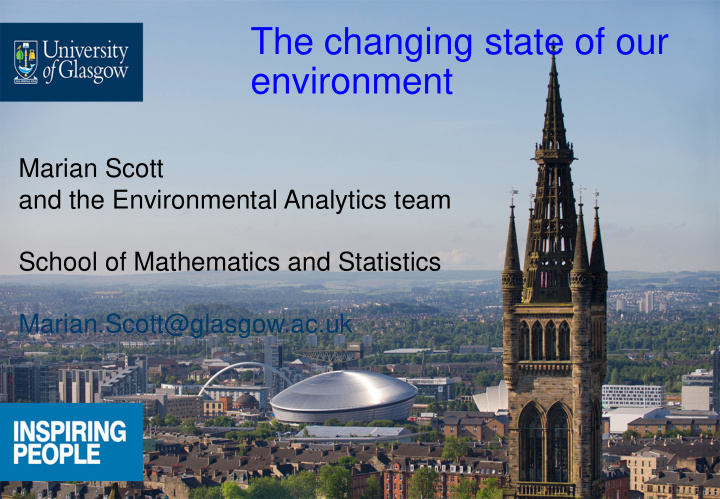



The changing state of our environment Marian Scott and the Environmental Analytics team School of Mathematics and Statistics Marian.Scott@glasgow.ac.uk
Our natural capital “ a cleaner, healthier environment benefiting people and the economy” Big data solutions to challenges in: Climate, Air, water (quality and quantity), transport, our urban environment, and for The nexus: water-waste-energy-food-climate
Our research delivers Intelligence in: • Air quality management and modelling (and links to health) • Water quality across river networks, water quantity and flooding, designing monitoring networks • Climate impacts, resilience and sustainability • Cities of the future
Air quality and health Air quality (nitrogen dioxide, nitric oxide, ozone, carbon monoxide, sulphur dioxide and PM 10 and PM 2.5 ) in the UK over the last ten years has improved but is still perceived as a major health issue. Models and new sensor data to help us understand and manage air quality in our cities. Pollution from Cars, Dumbarton Great Smog of London Road Corridor, Environment (BBC News, 2002) Trust, 2014 http://www.cerc.co.uk/environmental-software/ADMS-Urban-model.html
Our cities Urban indicators relating to environmental and land-use have been developed. The indicator framework allows us to combine a variety of attributes to define quality and sustainability and link this to social attributes such as deprivation. Map of composite air, soil and water quality indicators at data zone level.
Our cities Sensors (mobile phones) can be used to map the dynamics of city life and environmental hazards such as earthquakes F Finazzi, Bergamo
• 20 years of data • 1000 lakes • each lake is observed many times by satellites. Remote sensing technology enables us to understand global patterns of lake water quality.
Our rivers New sensors means that we are creating very detailed records of diffuse pollution in rivers. When combined with statistical models, we can design new and more efficient monitoring networks. EPSRC Grant Ref: EP/M008347/1
The nexus Our water, energy and food systems are critically interconnected. Effects are present at different scales (national, regional, local and individual) and dimensions (social, civic, economic, physical, ecological, political and digital). I. Disaggregated water use data (spatial and sectoral) II. Disaggregated energy use data (spatial and sectoral) III. Supermarket use of energy and water IV. Agricultural use of energy and water V. Waste to energy data EPSRC Grant Ref: EP/N005600/1 VI. UK Crop distribution data WEFWEBS
Certainty and uncertainty The language of statistics expresses certainty and uncertainty, which we can visualise and communicate. For these three sites and years, red shows the trend in observed SO 2 values and green indicates where you would expect (with uncertainty) the values to lie under a model.
Environmental analytics Earth observation, new sensor development, social media are all generating unprecedented volumes of data and new statistical challenges to deliver intelligence in the environmental and ecological sciences. Our work helps regulators, scientists and citizens alike focus on real environmental outcomes while respecting the complexity and interconnectivity of our urban and rural ecosystems. Research supported by EPSRC, NERC and ESRC
Recommend
More recommend